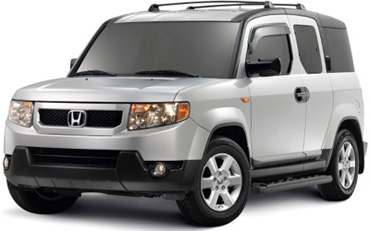
Although American Honda Motor Co. Inc.’s Element cross/utility vehicle is due for a full revision, a new model probably won’t be seen any sooner than 2010, a top executive confirms.
If it survives next year in its current form as expected, the Element, which debuted in late 2002 as an ’03, would become the longest-running high-volume Honda model to date in the U.S., surpassing the first-generation Civic’s lifespan, which ran from ’73-’79.
Honda’s S2000 has had a longer lifecycle than both the Element and first-generation Civic, but sells in very small quantities. The same was true for the now-defunct Acura NSX sports car.
“Element continues to plug along (and) has a very loyal following,” John Mendel, executive vice president, says of the reason behind the vehicle’s relatively unchanged six years in the market.
Honda spokesman Ed Miller says the Element’s long lifecycle isn’t reflective of an emerging trend at Honda, which historically has maintained a 4- to 6-year product cycle.
Because of its “unique design” the Element is a unique case, Miller says.
“It has a little more staying power (because of its distinctive styling). It’s actually more like a sports car than a sedan, (in that its) sales follow sports car patterns,” he says, referring to the demand phenomenon that sees sports cars sales catch fire quickly then fall off sharply.

Deliveries have declined steadily since the Element’s first full year on the market in 2003, when Honda sold 67,478 units in the U.S. Last year, Element demand plunged 32.1%, to 35,218 units from 51,829 in 2006. Through November, Element sales are off 22.4% from year-ago to 25,111 units.
In the six calendar years it’s been on the market, Honda has performed two “mid-cycle” refreshes of the CUV.
For ’07, Honda added the upscale SC trim that boasted various interior and exterior styling tweaks, 10 more hp and a stiffer suspension than the Element LX and EX models.
And for ’09, the Element gets exterior and interior appearance changes for all three trims; optional voice-activated navigation system with rearview camera for the EX and SC with automatic transmission; and, for the EX, a new “convertible” center console with a removable cooler.
Although it has had a reputation as an older person’s vehicle, Power Information Network data shows the average age of Element buyers has held steady over the past two years, at about 44 or 45, depending on the quarter.
The similarly boxy Scion xB from Toyota Motor Sales U.S.A. Inc. typically has drawn older buyers, says Tom Libby, senior director-industry analysis at J.D. Power & Associates PIN.
“More often than not (the xB) has not been one of the models with the youngest customer ages in the industry,” Libby says.
But the xB, which received a full redesign last year for ’08, is in positive territory for the year, with sales up 3.3% through November to 43,426 units, Ward’s data shows.
The xB typically has been a top-10 cross-shop for those looking to buy an Element, says Jackie O’Dowd, senior associate-automotive of Compete Inc., a Boston-based Web analytics company.
In October, the xB was the second-most cross-shopped vehicle online by those considering the Element, and in November it placed third, Compete data shows.
However, for the year the xB is in eighth place on the list of models Element owners typically cross-shop online. Honda’s own CR-V and Toyota’s RAV4 small-midsize CUVs place first and second on the list.
Both the Element and xB stand to be challenged next year by two new box-on-wheels entrants: Nissan North America Inc.’s Cube and Kia Motors America’s Soul.
Like the first-generation xB, the Soul and the Cube ride on B-segment platforms while the Element and current xB are C-sized models.



